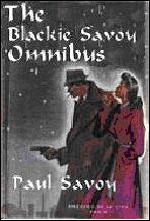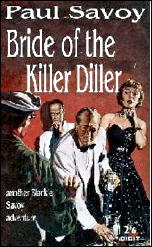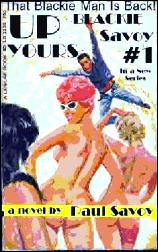|
The
Adventures of Blackie Savoy: A Brief
History of the
Screwball World of Paul Savoy by David L. Vineyard
“I’m not fond of
your methods, mon cher
Blackie,” Inspector Dupont of Interpol said, “but not for nothing do
they call you ze world’s greatest detective.”
– Black
Moon of the Mummy, by Paul
Savoy
 There isn’t a great deal known about Paul Savoy, the
author of the long running Blackie Savoy saga. He
seems to have been born in Tasmania in 1888 with an
Irish father and
English mother, and have grown up in New South Wales on a sheep station
where
his mother was a cook and his father chief sheep shearer.
There isn’t a great deal known about Paul Savoy, the
author of the long running Blackie Savoy saga. He
seems to have been born in Tasmania in 1888 with an
Irish father and
English mother, and have grown up in New South Wales on a sheep station
where
his mother was a cook and his father chief sheep shearer.
His childhood is a mystery, and there is little record of him at all until 1904 when at age sixteen he showed up in Perth as a reporter on the Daily Grind, a local newspaper. A year later he began his career as a fictioneer in the Australian weekly Lads and Laddies, a local imitation of the famed British Boys Own Paper, contributing to the adventures of Lord Saxton Bleek, a cross between British pulp sleuth Sexton Blake and schoolboy sleuth Nelson Lee. Between 1904 and 1920 Savoy contributed some four million words to the sagas of Lord Bleek, the Justicer (a proto super hero possibly created by Savoy and with some ties to his Blackie Savoy), girl sleuth Mary Nice (for Lassies and Lasses, a sister publication of Lads and Laddies), and Sam Sunderman, an Outback sleuth with some resemblance to Arthur Upfield’s half aborigine Bony. Savoy married in 1922 and settled down to a career in advertising, but unable to make ends meet he decided to try and start his own publishing empire with The Boys Own Adventure, a slavish imitation of The Boys Own Paper. He soon lost all his money and was forced into bankruptcy, but did contribute one new character of interest, The Honourable Bart [1], who had many things in common with Blackie Savoy, including a female companion named Wanda – though without the romantic interest that marked the Blackie Savoy saga. 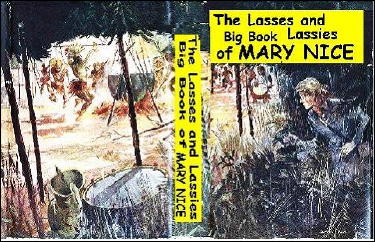 By
1929 the gentleman
adventurer was in full swing in popular fiction, and taking note of the
success
not only of Sapper’s (H.C. McNeile)
Bulldog Drummond, Leslie Charteris’s the Saint, and with nods to his
own Lord
Bleek and the Honourable Bart, Savoy pounded out the first adventure of
Blackie
Savoy over a long drunken weekend in Sidney [2]
while he was supposed to be covering the cricket matches. By
1929 the gentleman
adventurer was in full swing in popular fiction, and taking note of the
success
not only of Sapper’s (H.C. McNeile)
Bulldog Drummond, Leslie Charteris’s the Saint, and with nods to his
own Lord
Bleek and the Honourable Bart, Savoy pounded out the first adventure of
Blackie
Savoy over a long drunken weekend in Sidney [2]
while he was supposed to be covering the cricket matches. Savoy lost his newspaper job, but a career was born. “The Bloody Big Footprint” appeared in the October Australian edition of the British pulp Thriller headlined as “introducing that marvelous new sleuth, Blackie Savoy.” This is how we first meet Blackie:
A man
sailed into the room like a destroyer cutting through the wake of an
angry
ocean. He was smaller than a mountain,
but no less prepossessing, a big, smiling, handsome devil of a man with
a pane
of glass in his left eye (he had lost partial sight in that eye thanks
to the
butt of a German rifle, and finished the dirty hun who cost him that
vision
with his bare hands). His eyes were the
gray of sea ice sludge, and his wavy hair blue black.
A Douglas Fairbanks mustache sat on his upper lip above
his wide
smiling mouth of dazzling white teeth like ivory tombstones.
“By, Gad,” Blackie Savoy exclaimed at the top of his voice to no one in particular. “I could use a bloody brew I could. Fightin’ the unholy and unwashed is deuced thirsty work I tells you.” Also present is Wing, Blackie’s Chinese valet and man Friday, and his yellow Hispano-Suisa salon car. (In the post war era it was replaced by a more sedate Bentley.) Neither Wanda nor Dr. Humbolt Morphy, his greatest antagonist make their debut here, but the basic format for Blackie's adventures is set. Blackie is the son of a wealthy Australian peer who sent him to England for his education. Sent down from Oxford for thrashing a Bolshie tutor (his father was secretly proud, but of course could not express that sentiment). To keep himself in the manner to which he and Wing are accustomed, Blackie begins to write true crime sagas, and along the way solve crimes the police are too incompetent to handle. [3] In “The Bloody Big Footprint” Blackie is researching a book on the Cornwall Conker, a serial offender who conks unsuspecting victims on the head and relieves them of their watches. While looking into the Conker’s latest crime he spots a huge animal footprint as is told of a local legend of a spectral dog that accompanies the Conker. Intrigued by the ‘bloody big footprint’ Blackie and Wing follow a lead to a local breeder of horses and discover the stables cover a white slavery ring. The ‘Conker’ is one of the squires henchmen who has been attacking those who get too close to the operation and steals their watches for fear they will realize the time of the crime coincides with the arrival of certain ships on the Cornish coast used to smuggle out the poor women victims. Blackie is captured and left to die in a fiendish trap [4], makes one of his patented escapes, and brings the forces of the law down on the operation after strangling the ‘Conker’ with his bare hands. The spectral hound is only a very big dog that the mastermind keeps disguised as a small pony with his other animals. Dupont ends the tale with a familiar flourish for the first and not the last time in the saga.
“Not
for nothing are you called ze great detective, Blackie,” Dupont said
admiringly.
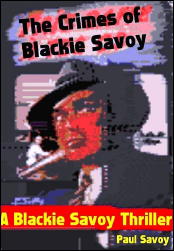 The first
four Blackie
stories are published in book form in 1930 as The Crimes of Blackie
Savoy
(Savoire Faire Press, Perth). The first
four Blackie
stories are published in book form in 1930 as The Crimes of Blackie
Savoy
(Savoire Faire Press, Perth). She was the love of his life. Tall, statuesque, yet willowy of limb and with the strength of a Channel swimmer, she might have been some ancient goddess, fully the equal to her man who worshiped the ground she walked on. The magnificent red haired actress and mannequin seemed born to stand by Blackie Savoy’s side and hang on his arm – when his hands weren’t needed for more violent pursuits. No few men envied Blackie Savoy the beautiful Wanda deLicht of the achromatic eyes (one gray green, one gray blue), but those eyes were only for him, her knight in armor, her Lancelot, her Lochnivar. Wanda and Blackie never marry, yet it is clear they live together, though until late in the saga when the books deteriorated to soft porn there is no consummation of the relationship. No one ever seems to mind, and even the most narrow minded of their hosts in their travels never seem bothered by Blackie and Wanda sharing a room. Early on Wanda is often traveling with Blackie as he researches his true crime books, but in some later books Blackie is traveling with her as she takes on an acting assignment or modeling job. [5] This second book is also notable for introducing Blackie’s nemesis, that genius of crime, Dr. Humbolt Morphy: 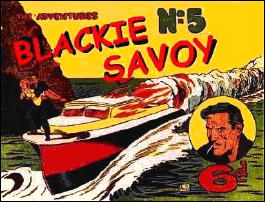 A small
twisted man with a huge head which housed his great brain, it looked as
if his
great head would have at any moment unbalance him and send him crashing
to the
floor, and yet somehow his slight form – disguising steel muscles and
unnatural strength as Blackie Savoy could attest – carried its great
burden
with the grace of a Nijinsky. His
features were brutishly ugly, with a high brow a pugnacious jaw, piggy
close
set red eyes, and wiry red hair sprouting everywhere on his skull. His unfortunate students, in his younger
days before he turned to a life of crime, had dubbed him Quasimodo. In pay back for that insult half a dozen of
them had died in agony from an extract of the poisonous datura plant
placed in
their biscuits at high tea.
A small
twisted man with a huge head which housed his great brain, it looked as
if his
great head would have at any moment unbalance him and send him crashing
to the
floor, and yet somehow his slight form – disguising steel muscles and
unnatural strength as Blackie Savoy could attest – carried its great
burden
with the grace of a Nijinsky. His
features were brutishly ugly, with a high brow a pugnacious jaw, piggy
close
set red eyes, and wiry red hair sprouting everywhere on his skull. His unfortunate students, in his younger
days before he turned to a life of crime, had dubbed him Quasimodo. In pay back for that insult half a dozen of
them had died in agony from an extract of the poisonous datura plant
placed in
their biscuits at high tea. Morphy is somewhat more hands-on than most super criminals, depending on himself more than his minions, and little wonder:
“I
tell you, Savoy, the downfall of all great men is the reliance on their
lieutenants. Alexander, Caesar,
Napoleon, all were laid low by the failures of men in their employ. I, on the other hand, rely only upon
myself.”
“Must
be a great comfort,” Blackie said, “When your absurd schemes
inevitably fail.”
Morphy’s
red eyes flared, then he gained control of himself.
“Crime is an art, Savoy, and all art is a process of trial
and error.
“Hmm,
make an error, and you end up on trial, eh?”
There is brief pause in the saga during the Second World War where Paul Savoy distinguished himself as a conscientious objector, but at war’s end Blackie returns having served as a commando in a special unit directly under the command of Winston Churchill. [7] After a few false notes Savoy takes a note from Peter Cheyney and Mickey Spillane and gives us a tougher and more modern Blackie and Wanda. Blackie has disposed of his old Webley Fosbury for a .45 automatic, and Wing, his faithful valet, has been retired to whatever home for used men Friday will have him. From I, the Executer (1951):Her eyes were going dark, but she heard Blackie’s last words. Mademoiselle Lemaire is the mistress of Dr. Morphy. Blackie later took on something of a Bondian cachet as the mood of popular fiction changed yet again. From On Service For Her Majesty (1964) : But by the seventies Blackie’s sales were down, and Savoy seemed unable to adapt to the new world. The last of the hardcover Blackie’s appeared in 1970 (Guns for a Nosegay) and after a five year hiatus, the next Blackie Savoy book (Up Your's Morphy) appeared as a paperback original from Narcosis Press, a soft porn publisher. More books appeared over the next five years before news reached these shores that Paul Savoy had passed on, having fallen off an excursion boat in Sydney Harbor and not being noticed until it was too late. The body was never recovered, believed eaten by sharks who no doubt suffered an epic hangover. In a way he wrote his own epitaph in the final Blackie adventure, In the Cockpit (1979). “We’ve had a good run of it, Wanda, my love. A good run, don’t you think?” “Oh yes, Blackie, a splendid run.” It’s been great fun hasn’t it?” “Splendid, old girl. Splendid.” 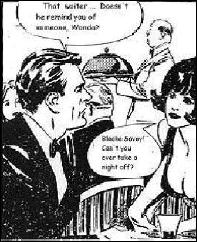 Print wasn’t the only
medium Blackie conquered. As early as
1933 their were feelers for a Blackie Savoy movie, and in 1935 Blackie
made his
debut in Blackie
Savoy Gets His from a local Australian film
company. The film is lost, but reviews
were less than enthusiastic. In 1938
Savoy’s old paper, The
Daily Grind began a Blackie Savoy comic
strip
called simply Blackie
Savoy that would run off and on until
1962 when
it was pushed out by reprints of Rupert Bear. Blackie
also had a long career on radio in a fifteen
minute serial five
days a week The
Adventures of Blackie Savoy.
Print wasn’t the only
medium Blackie conquered. As early as
1933 their were feelers for a Blackie Savoy movie, and in 1935 Blackie
made his
debut in Blackie
Savoy Gets His from a local Australian film
company. The film is lost, but reviews
were less than enthusiastic. In 1938
Savoy’s old paper, The
Daily Grind began a Blackie Savoy comic
strip
called simply Blackie
Savoy that would run off and on until
1962 when
it was pushed out by reprints of Rupert Bear. Blackie
also had a long career on radio in a fifteen
minute serial five
days a week The
Adventures of Blackie Savoy.
There were numerous planned Blackie Savoy projects throughout the 1950's, but it wasn’t until 1961 that the syndicated television series Blackie Savoy made its debut with Lawrence Lothar as Blackie, Caroline Lotta as Wanda, Jean-Paul Sartre [8] as Inspector Dupont, and Maximilian Zamphir, the great Hungarian actor, as Dr. Morphy. The series ran from 1961 through 1965 in some 80 episodes that have seldom been seen since. The Complete Blackie Savoy can be had on DVD in the rare Region 3 format. [9] Paul Savoy is an interesting footnote in the story of the Australian crime novel. His creation Blackie Savoy, one of the longest running of all series characters, though largely forgotten today, remains a fascinating character to modern readers. Savoy remained throughout his career as most eccentric and unusual writer, and one who remains the bane of collectors thanks to his many publishers and difficult to find works.
Bibliography of
Blackie
Savoy:
The Crimes of Blackie Savoy (consisting of The Bloody Big Footprint, What Big Eyes You Have Little Girl, Don’t Shoot It’s Blackie Savoy, and Shoot Quick It’s Blackie Savoy) The Lethal Legatee (also
published as Wanda
Gets It Done)
Blackie Savoy Takes the Bait Catch Him By The Toe (the most difficult of the books to find, murder among the Aborigines) Shoot Or Don’t The Blackie Savoy
Omnibus (consisting of The Lethal Legatee,
A Long Lay
for Blackie
Savoy, Blackie
Savoy Takes the Bait, and Shoot Or Don’t) The Many Crimes of Blackie Savoy (consisting of “Scotched by the Scots,” “Wanda's Naughty Bit,” “Not Now Dr. Morphy!”, and “Blackie Shoots His Bolt”) Test Match for Murder More Crime for Blackie Savoy (consisting of “The Foul Fiend of Finagel,” “The Round About Rondelle,” “Who’s Dat Blackie Savoy?” and “He’s Dat Blackie Savoy.”) Contraband for Blackie Savoy I, The Executor Kill Me
Dead 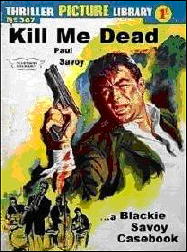 Vengeance is a Mime’s Bride of
the Killer
Diller
Sing Sing For Your Supper The Black Moon of the Mummy On Her Majesty’s Service You Only Live Until You're Dead Thunder RoyaleGun For a Nosegay Up Yours Blackie Savoy
(first of the soft porn paperback originals)
Wanda’s Wicked Wish Laid Low
by Blackie
Savoy
Black Garters and Fishnets for Wanda The Power of Fishnets The Lusty World of Blackie Savoy In the Cockpit * Blackie’s Long Night (not by Paul Savoy; seems to have been written to fulfill a contract by his sixth wife and stepson) * Shoot Fast Blackie Savoy (not by Paul Savoy, based on the radio serial)
Films: Blackie Savoy Gets His (1935, Centaur Studios; 72 minutes, with Hopewell Hoppe as Blackie)
The Adventures of Blackie Savoy.
A 15 minute daily serial (1945 - 1962)
with
Compton Courier-Quiss as the voice of Blackie. Television: Blackie Savoy
(1961-1965) Note: In 2003 a new Blackie Savoy film was announced to star Jude Law, but nothing has come of it yet.
Gems from the Blackie Savoy saga: 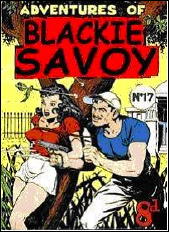 “I never
suspect,
Inspector. I know.” “I never
suspect,
Inspector. I know.” “You suspect this is ze work of ze Dr. Morphy?” “I know.” “Your Miss deLicht is quite a throroughbred, Mr. Savoy.” “She’s good in the stretch,” Blackie said. “Ze dead, they do sometimes talk, mon ami,” Inspector Dupont said. “Sometimes they won’t bloody well shut up,” Blackie sighed. “Tell me Miss deLicht, just how do you get the stubborn Mr. Savoy to follow you so willingly? I would be grateful for your secret.” “I’m sorry Dr. Morphy, but I don’t really think fishnets and garters would work for you.” “Not for nothing is ze Dr. called a criminal mastermind.” “There can be no doubt, this is the work of that madman Morphy, he is insidious.” “Fiendish.” “Mysterious.” “The Yellow fiend.” “Ah, yes, I forgot his jaundice.” As Blackie and Wanda descended from the bus they eyed the sign noting the Western Australian town Distraction, population 135. “Well,” Blackie said. “I think I can honestly say we have finally been driven to Distraction.” “Not for nothing ...” “Am I the world’s greatest detective?” “Really, mon ami, your ego, it is getting how you say, out of control?” “Blackie, do you really think Dr. Morphy is finished once and for all?” “Well, Wanda, at least until that lush who writes these things blows his latest advance.” [1]
The Honourable Bart, was Lucifer Bart
esq.,
the son
of peer and the best amateur bowler (cricket) in Australia began his
career
solving crime while still a student at Havorford. [2]
Savoy’s drinking
was legendary. According to his fourth
wife by age 50 he
was consuming two fifths of The Glenlivviet a day.
In later years as his funds dried up he was reduced to
generic
Scotch. Savoy continued to imbibe his own favorite Laphrohaig
(see “Scotched by
the Scots” in The
Many Crimes of Blackie Savoy,
adapted for the syndicated television series Blackie Savoy
(1961-1965) [3]
Paul Savoy was once arrested in a riot
that broke out at a cricket test match
in Sidney and forever after portrayed the police as uniformly stupid. Blackie as not only hindered by them, but
often hunted as a fugitive through their misinformation -- but they
are always
slavishly grateful when he produces the real villain. [4]
The first of a long line of fiendish
traps
that
plague Blackie and Wanda, and from which he escapes with the regularity
of
Houdini. In “The Foul Fiend of
Finagel” Blackie is left chained and unconscious at
the bottom of an
abandoned well fed by a nearby river. As
the natural dam that has blocked the well and made it
dry breaks and
the flooded river fills the well Blackie lies helpless.
The next chapter begins: “Having
escaped Morphy's deadly trap
...” [5]
In Black Moon of
the Mummy
(1961),
Blackie is
in Egypt where Wanda is playing Nefertiti in a film about the apostate
pharaoh
Akenhaten. A series of murders by a
black wrapped mummy turn out to be another of Dr. Morphy's fiendish
plots, this
one to steal the treasures of the secret tomb of Nefertiti where the
film is
unwittingly doing location work. [6]
Never let it be said Savoy misses a
chance
to use a
stereotype. [7]
“The
PM never spoke of Blackie without a touch of moisture in the corner of
his
eye.” Contraband for Blackie
Savoy (1947) [8]
Obviously not the Jean-Paul
Sartre,
but a
distant cousin. [9]
Region 3 DVD’s can
only be played on DVD
players made
in Burma Email address: |
